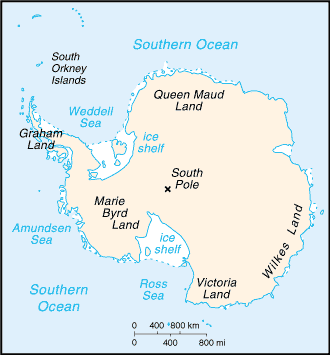
|
Antarctica
Background:
Speculation over the existence of a "southern land" was not confirmed until the
early 1820s when British and American commercial operators and British and
Russian national expeditions began exploring the Antarctic Peninsula region and
other areas south of the Antarctic Circle. Not until 1840 was it established
that Antarctica was indeed a continent and not just a group of islands. Several
exploration "firsts" were achieved in the early 20th century. Following World
War II, there was an upsurge in scientific research on the continent. A number
of countries have set up year-round research stations on Antarctica.
Location:
Location: Continent mostly south of the Antarctic Circle
Area: Total: 14 million sq km land: 14 million sq km (280,000 sq km ice-free,
13.72 million sq km ice-covered) (est.)
Area - comparative: Slightly less than 1.5 times the size of the US
Coastline: 17,968 km
Climate and Terrain:
Climate: Severe low temperatures vary with latitude, elevation, and distance
from the ocean; East Antarctica is colder than West Antarctica because of its
higher elevation; Antarctic Peninsula has the most moderate climate; higher
temperatures occur in January along the coast and average slightly below
freezing
Terrain: About 98% thick continental ice sheet and 2% barren rock, with average
elevations between 2,000 and 4,000 meters; mountain ranges up to nearly 5,000
meters; ice-free coastal areas include parts of southern Victoria Land, Wilkes
Land, the Antarctic Peninsula area, and parts of Ross Island on McMurdo Sound;
glaciers form ice shelves along about half of the coastline, and floating ice
shelves constitute 11% of the area of the continent
Return to Visiting Locations
|
|
People:
No indigenous inhabitants, but there are seasonally staffed
research stations
Government:
Government type: Antarctic Treaty Summary - the Antarctic Treaty, signed on 1
December 1959 and entered into force on 23 June 1961, establishes the legal
framework for the management of Antarctica.
Economy overview:
Economy - overview: Fishing off the coast and tourism, both based abroad,
account for the limited economic activity. Antarctic fisheries in 2000-01 (1
July-30 June) reported landing 112,934 metric tons. Unregulated fishing,
particularly of tooth fish, is a serious problem. Allegedly illegal fishing in
Antarctic waters in 1998 resulted in the seizure (by France and Australia) of
at least eight fishing ships. The Convention on the Conservation of Antarctic
Marine Living Resources determines the recommended catch limits for marine
species. A total of 12,248 tourists visited in the 2000-01 Antarctic summer,
down from the 14,762 who visited the previous year. Nearly all of them were
passengers on 21 commercial (nongovernmental) ships and several yachts that
made trips during the summer. Most tourist trips lasted approximately two
weeks.
Statistics:
Airports: 30
Airports - with unpaved runways: Total: 19.
Heliports: 27 stations have helicopter-landing facilities.
|
